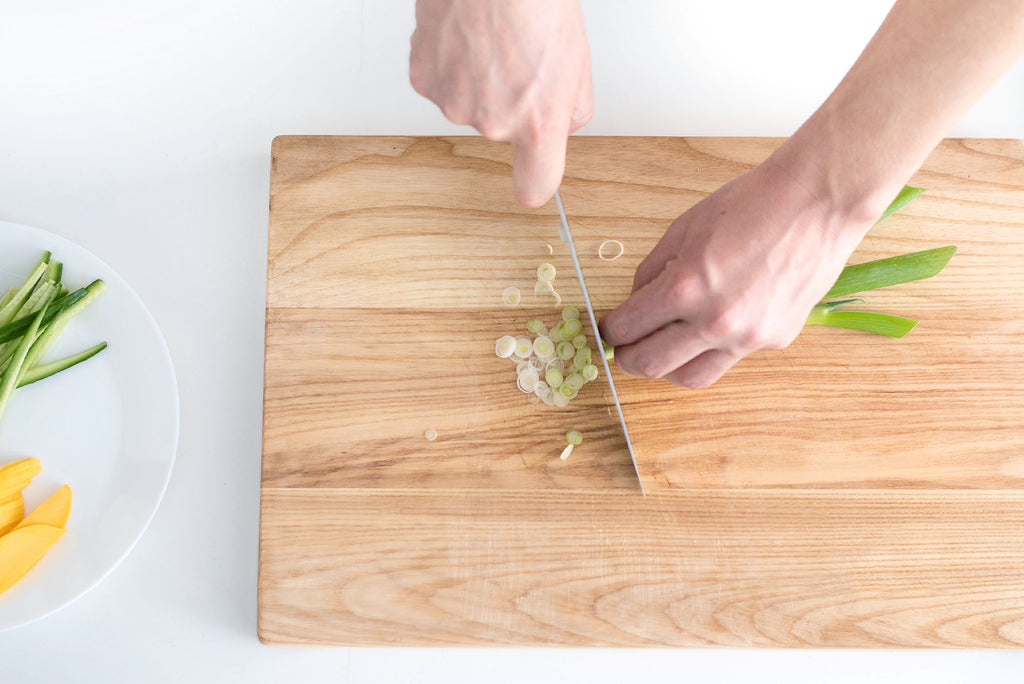The Best Cutting Board Oil (Bonus: It’s Also the Most Affordable)
 To maintain the smooth surface and longevity of a cutting board, apply oil once or twice a year.
To maintain the smooth surface and longevity of a cutting board, apply oil once or twice a year.
- Cutting board oil is essential to keep your wooden cutting board from absorbing moisture and cracking or splintering.
- If you choose the wrong cutting board oil, it could go rancid on your board.
- You should clean and dry your board thoroughly before oiling, then oil it at a time when you can leave it to soak overnight.
Most oils we use in the kitchen are cooking oils — olive, canola, avocado, grapeseed, etc. However, there’s another important oil to add to your pantry — oil for your cutting board.
You’ve done your research, shopped around, and finally found an affordable, high-quality wood cutting board for your kitchen. Because wood is an organic material, this board will need to be regularly oiled to keep from drying out.
In fact, anything made from unvarnished wood, including butcher blocks, wooden bowls, and wooden spoons, will eventually splinter or crack if not conditioned properly.
The following article goes over the benefits of oiling your cutting board, the steps to apply the oil properly, and how often to do it to turn your wood cutting board into a well-oiled kitchen implement.
Why Oil Your Cutting Board
Cutting boards, being simple slabs of wood, may not seem like they need much attention. But they do. Wood is a natural, porous material that changes through time. Whether it becomes dry and splintered, or develops a beautiful, glossy patina is up to you.
To achieve the latter requires a regular oil regimen. Not only does oil effectively soak into the wood and keep it smooth and supple, it also acts as a mild water-repellant. A wooden cutting board that stays wet or in water for a period of time becomes prone to building bacteria or warping. Eventually, the board may even split and be unsafe for use.
Plus, having a protective layer also helps prevent any juice or liquid stains from adhering to the cutting board surface. So if you love a fresh beet salad or enjoy sipping a glass of wine while cooking, oiling your cutting board will protect it from accidental stains or spills.
What Cutting Board Oil to Use
 Food-grade mineral oil is transparent, has no odor or taste, and is the best cutting board oil.
Food-grade mineral oil is transparent, has no odor or taste, and is the best cutting board oil.
The best oil to use on your cutting board is mineral oil (also called liquid paraffin). Although there are many elaborate, brand name options out there, mineral oil is still the best. Just be sure to buy mineral oil that’s FDA food-grade or USP-grade (by the United States Pharmacopeia), with the classification clearly listed on the label.
Pure food-grade mineral oil is very affordable — well under a dollar per ounce — and has no color, odor, or taste. What makes it perfect for kitchen use, however, is its resistance to oxidation.
Oxidation is a common occurrence in the majority of oil. When exposed to oxygen (as well as heat, moisture, light, etc.), oil will slowly become stickier, smellier, darker, and most likely, rancid. This is especially true for oils that are high in unsaturated fat, such as vegetable oil, olive oil, avocado oil, etc.
In contrast, mineral oil is able to resist oxidation, even if it’s exposed to oxygen or moisture — two common elements that come into contact with your everyday cutting board.
Of course, even food-safe mineral oil will eventually oxidize. But the addition of select antioxidants, usually Vitamin E, can help mineral oil last longer on your kitchen shelf, while still keeping it as pure as possible.
If you don’t want to use mineral oil, you can also use beeswax, beeswax-based board cream (usually a blend of beeswax and mineral oil), or fractionated coconut oil.
Other wood oils, like linseed, walnut, or tung oil, are not good choices, as they may contain allergenic materials or undergo a manufacturing process that renders them toxic for food contact surfaces.
How to Oil Your Cutting Board
A newly oiled cutting board should be left to soak as much as possible in order to reap the full benefits — anywhere from three hours to overnight is best. For this reason, it’s best to oil your cutting board at the end of the day or when you’re sure you won’t use it for the next few meals.
Before you begin applying oil, make sure your wood cutting board is thoroughly clean and dry. Any small food bits on the surface will likely be rubbed into the surface, so it’s best to start with a board that’s as clean as possible.
A good cleaning with warm soapy water and a soft sponge is usually enough. Make sure to rinse well and air dry. Never run a wooden cutting board through a dishwasher.
Now to start oiling. Pour a healthy dose of mineral oil evenly over one side of the wood cutting board. Don’t worry about being exact — you can continue adding oil as you work around the board. Using a clean, soft dish cloth or paper towel, rub the oil into the wood in the direction of the grain or in a circular motion.
Continue adding oil and rubbing it into the surface until the side has a nice shine and won’t absorb any more oil. Flip the board over and repeat the process. Make sure you get all the sides, as well.
It’s important to let the cutting board soak up as much oil as possible. Leave the board standing on its side or propped up against a vertical surface.
You can wipe away any excess oil after 5-10 minutes before leaving the board overnight. For especially dry or new boards, you can apply oil again a second or third time, or opt to apply a board cream using the same technique. Alternatively, you can simply leave the cutting board overnight and give it a quick wipe the next morning. Once you’ve removed all excess oil, you should be left with a beautiful new shine on your cutting board.
How Often to Oil Your Cutting Board
 When a wooden cutting board feels dry or quickly soaks up any liquid on the surface, it probably needs to be oiled.
When a wooden cutting board feels dry or quickly soaks up any liquid on the surface, it probably needs to be oiled.
As with cast iron cookware, many people like to season or oil a new wood cutting board before its first use. Even if the board comes pre-oiled, it may have dried up on the shelf or during transportation, and a nice coat of oil should get it back in shape. This, of course, is optional.
While there’s no hard and fast rule as to when you should oil your cutting board, there are a few ways to tell if your board is becoming dry. If some parts of your board look lighter or duller than other parts, this may be a sign that it needs to be oiled.
You can also sprinkle some water on the surface — if the water spreads or is absorbed into the wood, you have a very dry cutting board on your hands.
In any case, a good schedule is to oil your trusty cutting board once or twice a year, depending on how often you use it.
A Well Oiled Cutting Board
The process of oiling a cutting board is extremely easy. In just two steps — really, just rubbing oil onto the board and leaving it to sit overnight — you can reap a number of benefits and have a cutting board that will last many years.
The most important factor (other than remembering to actually oil your cutting board) is using the right oil. You need a food grade oil that doesn’t go rancid and is preferably odorless and colorless, which makes a good bottle of food-grade mineral oil your best choice.








